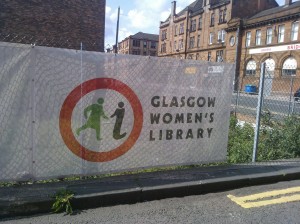Only a few weeks have passed since I have started working as an intern for the international conference “Cultural Encounters through Reading and Writing: New Approaches to the History of Literary Culture”, which will mark the conclusion of the Travelling Texts project. However, these few weeks have been filled with many discoveries: I have found out about the lives of various women authors who wrote between 1790 and 1914; I have explored the wonderful and welcoming space that is the Glasgow Women’s Library, where the conference will take place; and, last but not least, I have also dealt with more practical tasks, from making attempts at Photoshop to hunting for banner printers in Glasgow. In fact, a big part of our work as interns consists in the preparation of a display that will accompany the conference. Creating a display means finding a way to give a visible representation to all those connections between writers which are at the centre of the Travelling Texts project. So, while looking for the best means to physically represent the web of contacts that these authors had built across Europe, I have found myself chasing the visual remains that these women writers have left in the world of the Internet – where ‘connections’ are so ubiquitous and immediate, and images so powerful. As I was finding out more about how the authors’ ideas had spread and travelled, I was also looking for their photographs or portraits, and the facts that are remembered about them today.
However, it did not take me long to notice how little the Internet seems to know about them. There is, for example, Olly Donner: a Finnish author who lived between 1881 and 1956, and was received not only in nearby Sweden, but in France as well. Yet, Google only offers us some tiny photographs of her next to her husband, and few sources about her in languages other than Finnish. Another author which I was very much drawn to – and about whom, again, the Internet did little to satisfy my curiosity – is Zofka Kveder (1878-1926) a writer, playwright, translator and journalist who wrote in Slovene and Croatian, and whose own work has mostly remained untranslated. As Katja Mihurko Poniz portrays her, Zofka Kveder was a very important figure in the cultural life of Slovenia (which was then under the Austrian Empire) between the 19th and 20th century. Her writings engaged with ‘topics such as abortion, violence against women and suicide, which previously had been considered inappropriate in Slovenian literature’, explored ‘female identity and sexual desire’ in a captivating way, and denounced the difficulties faced by poor women in completing their studies, a subject which she knew first-hand. Throughout her life, she was also actively involved in women’s rights movements. Having found out about all this, I would love to be able to read her works: unfortunately, to the present day, this is practically impossible without knowing Slovene or Croatian. The conference, besides being a fantastic opportunity of further discovery about authors like these, will be animated by the purpose of directly addressing the question of ‘the Canon’, as well as of making those connections between authors more visible, just like the display aims to do on a smaller scale.
And so, while battling with technology in an attempt to find the best way to print a European map, I have also found myself marvelling at how, long before e-mails, books made it from Sweden to Greece, or from Finland to Spain. In fact, between 1790 and 1914 texts travelled not only as new ideas or ground-breaking concepts, but as physical objects. If the Internet tells us so little about it for now, books themselves do: during the conference, this tangibleness will be foregrounded by a section of the display, which will be dedicated to the photographs of the handwritten dedications upon the pages of various books. These were sent to Emilia Pardo Bazán by other women authors or readers, to fill her library in A Coruña. Hopefully, this will continue to happen, as participants to the conference might bring along new contributions to add to the collection of the Glasgow Women’s Library. This way, the conference, aside from investigating and visualising them, will also continue to build those ‘inter-connections’ that are so vital to literary culture: and being a part of all this, although a small one, is incredibly exciting.
